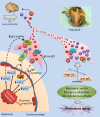Rejuvenating somatotropic signaling: a therapeutical opportunity for premature aging?
- PMID: 21212467
- PMCID: PMC3034170
- DOI: 10.18632/aging.100262
Rejuvenating somatotropic signaling: a therapeutical opportunity for premature aging?
Abstract
We have recently reported that progeroid Zmpste24-/- mice, which exhibit multiple defects that phenocopy Hutchinson-Gilford progeria syndrome, show a profound dysregulation of somatotropic axis, mainly characterized by the occurrence of very high circulating levels of growth hormone (GH) and a drastic reduction in insulin-like growth factor-1 (IGF-1). We have also shown that restoration of the proper GH/IGF-1 balance in Zmpste24-/- mice by treatment with recombinant IGF-1 delays the onset of many progeroid features in these animals and significantly extends their lifespan. Here, we summarize these observations and discuss the importance of GH/IGF-1 balance in longevity as well as its modulation as a putative therapeutic strategy for the treatment of human progeroid syndromes.
Conflict of interest statement
The authors of this manuscript have no conflict of interest to declare.
Figures

References
Publication types
MeSH terms
Substances
LinkOut - more resources
Full Text Sources
Miscellaneous

